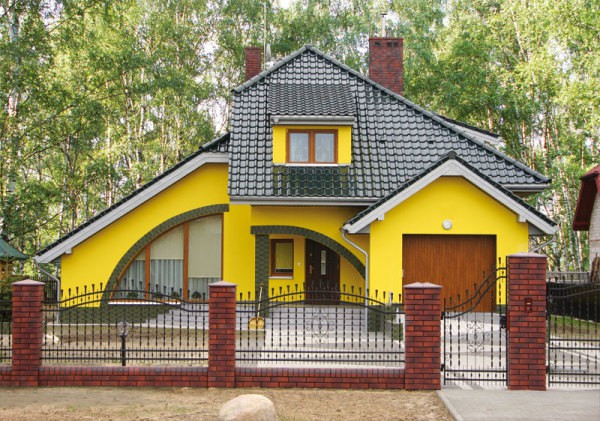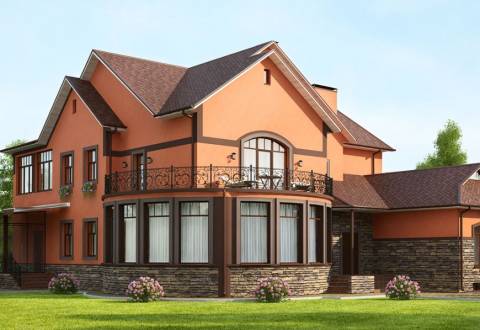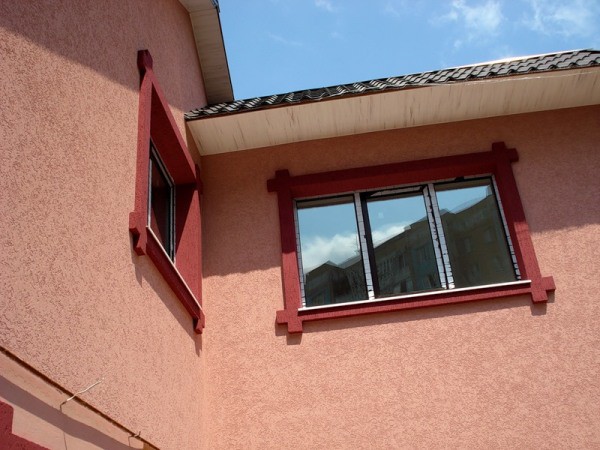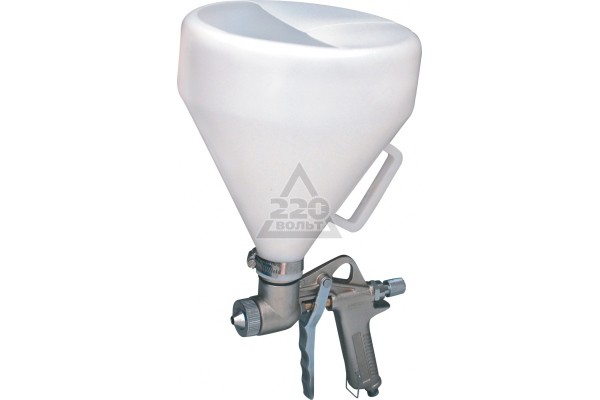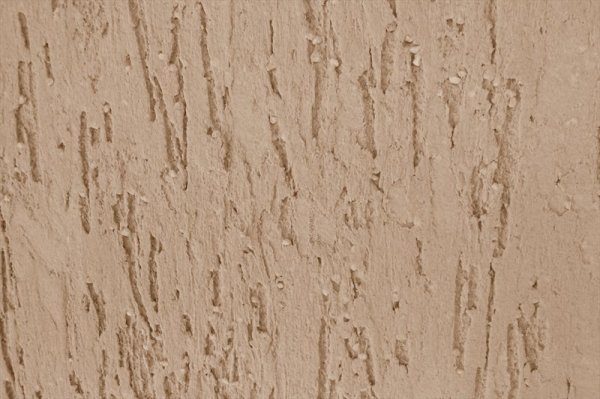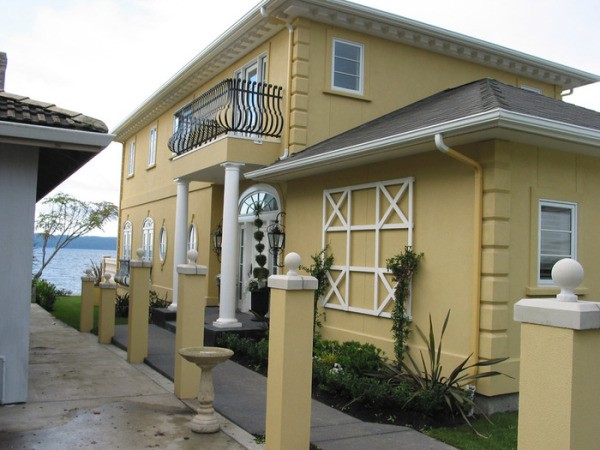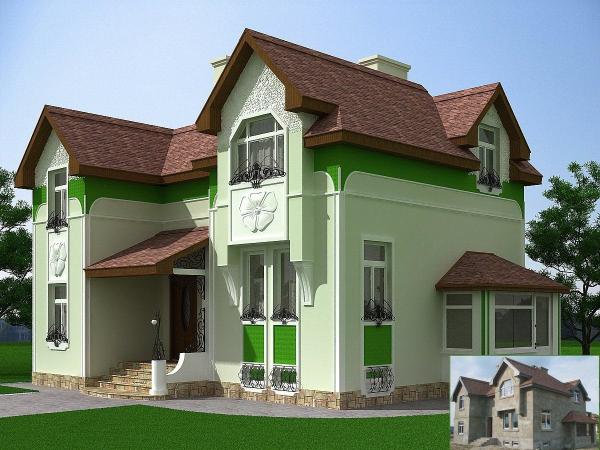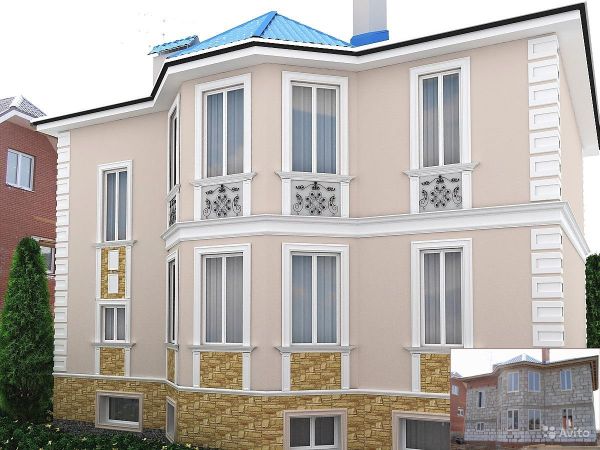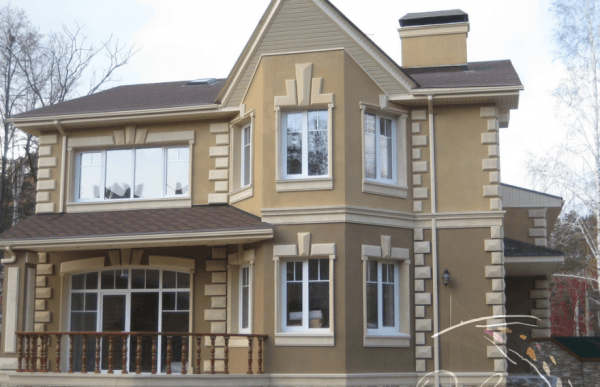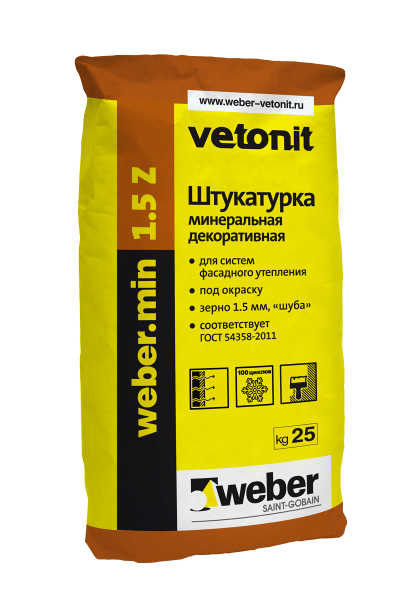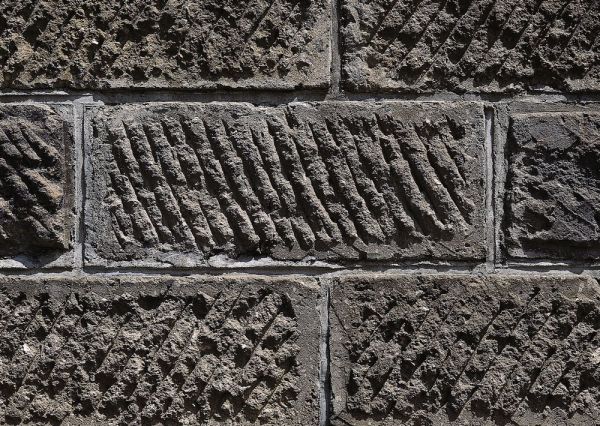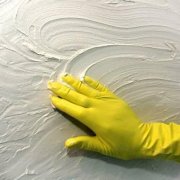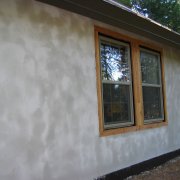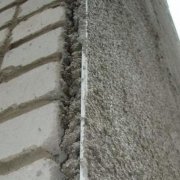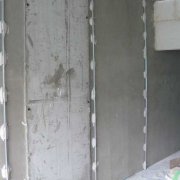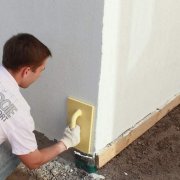Exterior wall plastering: traditional facade finish
How to make your home look original and memorable? The answer is simple: you need to turn to the traditional type of finish - plaster.
Facade decorative plaster for walls is a classic, it never goes out of fashion, and over time it only changes its tendencies. We will talk about what solutions and mixtures are used today for facade decoration.
And the video in this article on the topic: “Plastering the exterior walls with your own hands” will help you cope with this work yourself.
The content of the article
Exterior wall decorative plaster
All kinds of claddings, with stylization as stone, wood and brick (see Facing the facade of a house with brick and stone: tiles and thermal panels), make the facades faceless and similar to each other. You won't surprise anyone with such a finish today, but do you want something special? Believe me, decorative facade stucco for walls can solve this issue like no other material.
We will try to prove it to you by presenting you a lot of photos:
- You may ask why decorative plaster? Yes, because it does not require finishing painting and periodic updates. Modern plasters, enriched with polymer additives, serve for a long time, and are not afraid of atmospheric effects.
- Decorative plaster for exterior walls, is at the same time both leveling and finishing composition - hence its name. In composition, decorative plasters are not too different from conventional solutions. It’s just that they have colored or structuring mineral additives that allow you to achieve a certain aesthetic effect.
- The most popular options used today for facades, can be considered: textured plaster, where the aggregate is stone chips; synthetic thin-layer (microcement), colored lime-cement, and sgraffito.
Compositions and technologies for applying nakryvochnyh layers, as well as methods for their processing, are precisely that “highlight” that distinguishes these materials and makes it possible to obtain various decorative effects on the surface. Next, we will talk about each of these options in more detail, and we hope that our instructions will help you make a choice.
Pebble plaster
Stucco with stone “sprinkling” has long become traditional. Who has not seen the administrative facades lined with granite or marble chips?
Today there are many other options, and depending on them, you can use; the finished mixture, and only dilute it with water; purchase separately the basic composition, pigment and filler; make a solution directly at the facility.
So:
- The mortar for wall plastering outside is made on the basis of Portland cement, with a small addition of lime paste for ductility. Any technology for plastering external walls involves the implementation of at least three layers. These are: spray, leveling primer, and topcoat.
- Depending on the effect that is expected to be obtained, the screed can be processed at the setting stage, or already after hardening.Stone-like plaster, in which stone chips are on the surface, is performed using a special plastering tool called a hopper gun.
- It works from a compressor, and its task is to spray stone chips evenly on the surface. Hence its second name: “baby shred”. Just because the crumb does not stick to the surface, so it is pre-treated with paint-primer or PVA construction glue.
- The crumb is pounced by the hopper while the glue base is still sticky. After the glue dries, the decorative coating is covered with silicone varnish. It turns out a very strong coating, and the crumb will not crumble from it, even if you make a little effort.
- In some plasters, crumb stone is part of the mortar, or rather, in that part of it that is used to apply the topcoat. The decorative effect, however, is completely different. After the leveling soil has hardened, it is moistened with water using a spray gun, after which a textured layer is applied.
- After a day, it is washed with water, and do it until the flowing water is clean. This removes cement dust, and the pebbles on the surface begin to stand out prominently.
- When the purpose of plastering is to obtain a bark beetle surface, in the process of applying a coating layer, the grater is supposed to be kept at a certain angle. When the tool moves in different directions, you can get smooth or zigzag strokes that mimic a tree made by a bug.
The price of this type of plaster is quite affordable. And to fulfill it, having watched the video in advance, everyone can - there would be a desire!
Colored cement-lime mortar
The composition of the mortar for plastering the external walls (see Exterior decoration of the house with plaster: choose the option), like any other cement mortar, has a certain brand. After all, the screed should provide the walls with a reliable and durable coating.
The brand of cement-lime mortar used for facade work should not be lower than M50. Accordingly, the brand of cement used before milking it cannot be lower than M300.
- As a whitening substance, lime or marble flour, lime dough or fluff lime is used to create a solution. The percentage of this additive in the stucco mortar depends on the brand of cement: the higher it is, the more filler should be. If they took cement M300 - this is 20%, and if M600 - then all 50%.
- When marble flour is added instead of lime, the cost of the material is higher, and this is understandable why. The surface plastered with such a solution simply shines, because thanks to marble, the solution acquires an indescribable mother-of-pearl shade. It looks very beautiful, although it is quite expensive.
- But, it is not necessary to plaster the entire facade with marble plaster. If you need to carefully consider its design, then you can selectively decorate some architectural elements as a decor. For example, gables are decorated, and the remaining surfaces are finished with colored or pebbled plaster.
- Such an approach will help to give the exterior of the building a unique look, and we think that this can be seen quite well with the example below. In addition, graffito was also made here - the decor, which we will talk about in the next chapter.
- If the solution needs to be given a certain shade, color pigments are introduced into it. And here it is very important to keep the balance of ingredients. The pigment should be at least 5%, and not more than 15% by weight of the solution. If it is less than necessary, then the color is pale, with a dirty tint.Excessive pigment content can reduce the strength of the solution.
- As a filler, finely quartz sand is present in such plaster, and sometimes the same stone crumb is also present. Such solutions are prepared at on-site paint stations: first, grinding the pigment with lime in the paint grater. After that, all the ingredients are loaded into the mixer, and mixed until a solution is homogeneous in all respects.
Well, for the answer to the question: "How is the external wall plastering done with your own hands?" - you need to refer to the routing. It is the main document governing the production of these works.
Sgraffito
This term symbolizes not so much the type of plaster as the technique of applying it. In fact, this is not even stucco for walls, as such, but a design option for various architectural elements.
- Decor, as you know, over the entire area of the walls is not performed - at least, it will be very expensive. Anyway, when there are too many decorations, it turns out bad taste. It’s the same as hanging yourself with jewelry from head to toe.
- The essence of sgraffito technology is as follows: on a hardened layer of plaster of one color, a layer of a different color is applied, and while the screed maintains plasticity, a contour drawing is performed on it with a special tool. The composition of the solution for its implementation may be the same as we described in the previous chapter.
- But best of all, polymer-cement plasters are suitable for this purpose, as they have higher elasticity. When performing such a decor, the covering layers may not be two, but more. Moreover, each subsequent layer should be thinner than the previous one. This way you can create both flat and three-dimensional images.
As you understand, the query in the search line: “how to plaster the exterior walls of the video” - is unlikely to help you find such information material that easily teaches you the technique of graffito. In order to be able to perform such work, you need to be an artist, to have creative thinking.
If you have all this, mastering this type of finish will not be a problem for you.
Thin layer plasters
There is such a thing as “thin layer plaster”. What it is?
And this is a product of the general polymerization of building materials, which acquire qualities that were previously unusual for them. The most important thing for plaster is its plasticity. As a result of the introduction of polymer resins into its composition, this property is enhanced many times.
- Due to the high plasticity of the solution, it became possible to reduce the number of layers applied and make the screed as thin as possible (no more than 1 cm). The use of thin-layer plasters allows to increase the volume of work, and reduce the time for their completion. And for the customer and for the contractor - this is a direct benefit, since the cost of finishing work is significantly reduced.
- From the fact that the plaster layer on the walls is thinner, their appearance does not get worse. On the contrary, the solution during its application fills the smallest pores on the surface, and the level of adhesion, at the same time, is very high. Polymer plaster is not afraid of any atmospheric influences, and its service life is increased several times.
- Thin-layer plasters can be used on any basis, but with one condition: it should be fairly even. It is impossible to level the curved brick wall with a centimeter layer of screed - and this is a fact. So, before plastering the exterior walls, first evaluate the quality of the masonry.
- A solution for such a plaster does not need to be prepared on its own. There are mixtures on sale, both ready-to-use and dry. But the composition of thin-coat plasters may be different.There are, for example, mineral mixtures where white cement is used as a binder, and microfibre, or perlite, serves as a filler.
- These are the so-called warm plasters. In addition to the fact that this is a full-fledged heat-insulating material, thanks to the granular filler, a wonderful decorative effect is also created. Pigments are not introduced into the composition of mineral mixtures, and after plastering, the surface is simply painted with facade paint.
In polymer compositions, acrylic, latex, polyurethane, silicone are the filler. To give the mixture certain properties, hydrophobic or biocidal additives can be introduced into it.
There are also mosaic plasters, which include colored inclusions that create a decorative effect.
Synthetic solutions
Silicate plaster can also be classified as thin-layer options. It contains liquid glass, plus plasticizing additives. Such plaster is characterized by high strength and resistance even to aggressive environments.
- For facing buildings with a large area of facades, it is most often used. Builders make silicate plaster in the mixer, loading into it: PVA-based water-based paint, sifted fine quartz sand, potassium water glass and a gibrofobizator (water-repellent composition).
- All the ingredients are mixed until a homogeneous mass, and incubated for twenty minutes, until it has the necessary viscosity. Then, the solution, like a regular paint, is applied to a previously cleaned and primed wall using a spray gun and a roller. As a primer, in this case, liquid synthetic paint is used.
The decorative effect when applying such a plaster is often achieved by treating the base base mechanically. To put it simply, on the surface of the brick or blocks of which the wall is built, with the help of bouchards, they make such notches as in the picture above. They create an interesting relief that does not need to be aligned.
